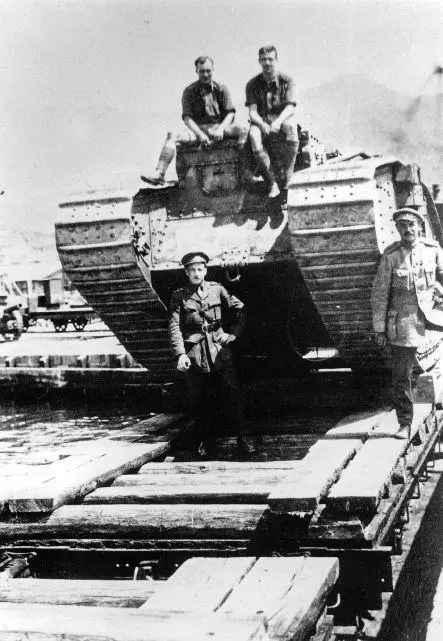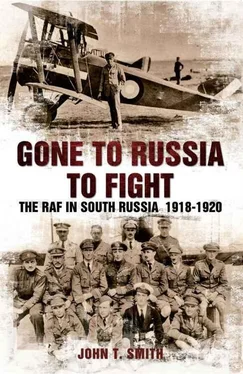The Volunteer Army by a brilliant counter attack drove the enemy out of Juschun and restored their position ultimately advancing a good number of versts. The enemy from subsequent reports suffered considerable casualties from aerial attack and their moral was certainly shaken by them. [1]

British tanks being transported on a rail flatcar during the evacuation.
Three sorties were launched on the following day to continue the attack, but bad weather forced their early return. Flying was possible again on 12 March, and two sorties were carried out, with enemy troop and transport targets being bombed and machine-gunned.
Bad weather stopped flying until 17 March, when Captain Langley and Lieutenant Brockley bombed the railway station at Novo-Aleksyeevka. During the raid they were attacked by two enemy aircraft and shot one down, as recorded in their combat report:
Combats in the Air. Squadron 47 [the pilots obviously still thought they were part of 47 Squadron]. Date 17/3/20. Type of Aeroplane DH9 2942. Time 3.5pm Armament 1 Vickers 1 Lewis. Locality Novo-Aleksyeevka. Pilot Captain M. J. Langley. Observer Lieut. T. W. Brockley. Height 4,000–5,000 feet. Result Driven down out of control. Remarks on Hostile Aircraft Nieuport single seater with powerful engine. Narrative. Two seater probable D. R. W. rear gun firing smoke tracer attacked from underneath while the other attacked from above. Two seater broke off engagement after 1 burst of 15 rounds at it. Nieuport pilot was evidently an experienced pilot, and made several determined attacks from all positions. As he was doing a heavy banked turn a burst of about 20 rounds was fired into him from the rear gun the tracers going right into him. He dropped into a vertical side slip for about 1,000 feet and then was seen to turn over into a vertical nose dive finally disappearing into the mist. [2]
Later on 17 March, Grigson and Gordon carried out a reconnaissance requested by the Russian staff. On the return flight, one of the big ends went on the engine and they were lucky to be able to return to Djankoi.
Langley and Brockley bombed infantry at Chongar on 18 March. Poor weather halted operations on 19 and 20 March, and the only flying carried out was a communications flight by Grigson, when he flew an Army Colonel Walsh to Theodosia and back to Djankoi. On 22 March, Langley and Brockley bombed the railway station at Djimbuluk and reported on the numbers of rolling stock in use on the Chongar Peninsula. The weather conditions again stopped flying until 28 March, when Grigson and Gordon carried out a reconnaissance of the front in the morning and reported things to be generally quiet. In addition, a group of cavalry and an artillery battery were bombed. In the afternoon, the same two attacked an armoured train north of Chongar. Several hits were obtained and the train was machine-gunned. These were the last flights carried out by A Flight.
The squadron diary for the rest of the month reads:
29/3/20. Orders received for detachment to proceed home via Theodosia. 30/3/20. 5 am Detachment train left Djankoi for Theodosia arriving at midday. 31/3/20. Detachment handed train to B.M.M. and embarked on H.M.T. Katoria at 4 pm for Constantinople via Sevastopol. [3]
Most of the flight personnel left on 31 March, though some of the senior officers left later.
Collishaw, in his book Air Command and in his log-book, claimed to have carried out at least seventeen sorties in the Crimea. This is probably more than the entire flight achieved. Records for only two flights by Collishaw can be found. He also stated that the aircraft were DH9As, but it seems reasonably certain that they were DH9s supplied by the Russians. The chronology and dates in his log-book for the retreat into the Crimea are wrong. This would seem to imply that the log-book was written up at a much later date and that he simply made some of it up.
In the Kuban, by early March, B and C Flights were in Novorossisk. Z Flight was still at Ekaterinodar to support what was left of Denikin’s Army. On 4, 5, 6, and 7 March, Z Flight RE8s dropped propaganda leaflets on Kuban Cossack villages in an attempt to keep them in the fight. One flight was fired on from a village close to Ekaterinodar. On 7 March, Major Archer moved back to Novorossisk to take charge of the evacuation plans. Captain Slatter took command of Z Flight. At Novorossisk, sixty other ranks volunteered to continue to serve in south Russia, but the majority chose to be evacuated to Britain. On 13 March, the RAF evacuated Ekaterinodar. The train took three days to reach Novorossisk on 16 March. Marion Aten claims the RAF train was attacked en route, but there is no mention of this. In any case, Aten was already at Novorossisk and had been for some time. Lieutenant Ritchie summarised the withdrawal:
We retreated to the sea where our aircraft were burnt. [4]
Back in Britain, the strength of the British Military Mission in south Russia was given in the House of Commons by Churchill, on 2 March, as 394 officers and 1,529 other ranks, including 93 officers and 291 other ranks of the RAF. By 18 March, all the RAF personnel were in the cement works at Novorossisk. This was situated high on a bluff overlooking the port.
At Novorossisk, Major Archer attempted to save as much of the RAF stores as possible. There were 250 tons of RAF equipment stored on the docks at Novorossisk. This did not include the twenty-three aircraft in storage – ten RE8s, nine Avro 504s, and four DH9s. The RE8s were wrecked, along with the spares for the type, because it was thought the Russian dislike for the type meant they were unlikely to be used effectively. To save the remaining thirteen aircraft, they were handed over to the Russians, who claimed they could ship them to the Crimea. But this did not happen, and on 26 March these aircraft were also rendered unserviceable. It was done in a hurry, as Archer stated in his report:
…there being then not even time to unscrew the instruments from the dashboards. [5]
Marion Aten claims that tanks were used to crush brand-new aircraft in their crates on the docks, but no other sources mention this.
In late March, the 6th White Russian Air Force unit, the one that had been on the same airfield as the British units on the Kharkov front in December, was on an airstrip in Grozni. To escape the Red advance, they flew over the Caucasus Mountains into Georgia. The unit’s four Sopwith Camels were taken into the Georgian air force. One of the pilots was Alexander Pishvanov, who later went to America and in the 1940s worked for Walt Disney. During the First World War, he had claimed five enemy aircraft shot down.
Most of the RAF personnel who had volunteered to serve in the Crimea sailed from Novorossisk on 24 March on board HMT Baron Beck . Archer stayed behind with a small party and the non-volunteers to finish the clearing-up. An attempt was made to help the Russian air force rescue as many of the aircraft they had been using as possible. It was thought that the Russians only managed to save around six DH9s and a small number of RE8s.
The situation in the town was utter chaos, as the defeated troops streamed in hoping for rescue. Major Jenks, who was with the Army in Novorossisk, wrote:
Novorossisk was crammed with refugees from all over the Don. Not often can one have seen people dying of wounds, typhus, starvation, exposure, drowning or just plain despair all at the same time and place. Trying to control the rush to get away was heart breaking; once the crowd in their panic broke through our cordon and swarmed onto a small ship overturning it and all on board into the icy water. [6]
Читать дальше













